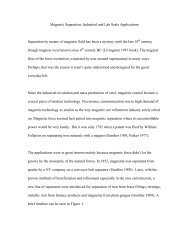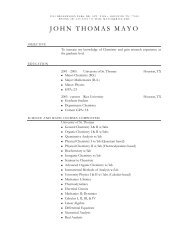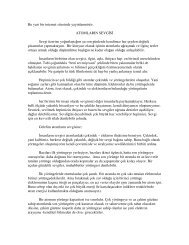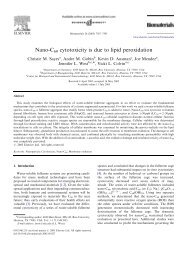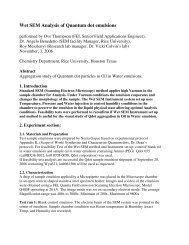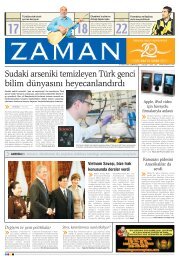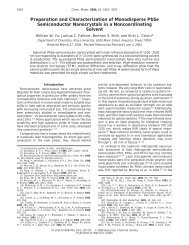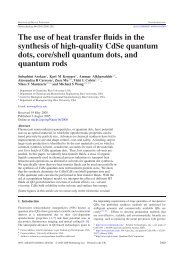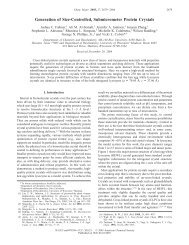Single-Crystal Colloidal Multilayers of Controlled Thickness
Single-Crystal Colloidal Multilayers of Controlled Thickness
Single-Crystal Colloidal Multilayers of Controlled Thickness
Create successful ePaper yourself
Turn your PDF publications into a flip-book with our unique Google optimized e-Paper software.
2134 Chem. Mater., Vol. 11, No. 8, 1999 Jiang et al.<br />
control <strong>of</strong> sphere size and concentration in solution. This<br />
deposition behavior can be adequately simulated using<br />
existing models <strong>of</strong> film formation developed for monolayer<br />
samples. The resulting planar colloidal crystals<br />
are highly ordered, and evaporation <strong>of</strong> the solvent leaves<br />
a silica-air array with good optical contrast and mechanical<br />
stability. The optical properties <strong>of</strong> these samples<br />
are measured at normal incidence and their qualitative<br />
features and trends compared to gravity sedimented<br />
colloidal crystals.<br />
Experimental Methods<br />
Materials and Substrates. All solvents and chemicals are<br />
<strong>of</strong> reagent quality and filtered by 0.22 µm syringe filters<br />
(Gelman) except for tetraethoxysilane (99%, Alfa) and 3-(trimethoxysilyl)propyl<br />
methacrylate (TPM, 98%, Aldrich) which<br />
are freshly vacuum distilled before use. The 200 pro<strong>of</strong> ethanol<br />
is obtained from Pharmaco Products, and 29.6% ammonium<br />
hydroxide is purchased from Fisher. Ultrapure water (18.2<br />
MΩcm-1 ) is used directly from a Milli-Q water system.<br />
Microslides (75 × 25 × 1 mm, Fisher) are cut into two equal<br />
halves along the long sides and are used as substrates. Glass<br />
scintillation vials (20 mL, Fisher) are used as experimental<br />
cells.<br />
Instrumentation. Scanning electron microscopy is carried<br />
out on a s<strong>of</strong>tware-controlled LEO 440 SEM designed specifically<br />
for electron-beam lithography. Transmission spectra are<br />
obtained using an Ocean Optics ST2000 fiber optic UV-near-<br />
IR spectrometer. A Coulter N4 Plus laser dynamic light<br />
scattering (DLS) instrument is used to size the particles. A<br />
CrC-100 sputtering system is used to sputter a thin layer (3-4<br />
nm) <strong>of</strong> gold on samples before SEM analysis.<br />
Colloid Synthesis and Purification. Monodisperse SiO2<br />
nanospheres are synthesized following the Stober-Fink-Bohn<br />
method. 66 Nanospheres with diameters ranging from 200 to<br />
700 nm and relative standard deviations smaller than 7% are<br />
obtained through strict control <strong>of</strong> the reaction conditions. 67 The<br />
sizes and size distributions <strong>of</strong> these samples are obtained from<br />
SEM and DLS measurements. Over 200 spheres are sized<br />
using SEM in order to arrive at the reported diameters. Before<br />
deposition, the silica alcosols are washed with 200 pro<strong>of</strong><br />
ethanol by repeated centrifugation and ultrasonic dispersion<br />
cycles in order to remove impurities, such as ammonia, water,<br />
and unreacted tetraethoxysilane. Six cycles are usually performed.<br />
3-(trimethoxysilyl)propyl methacrylate (TPM) coated<br />
silica is synthesized using a published method68 and purified<br />
as above. All microscopy data presented in this work, however,<br />
are from particles without TPM coating. The solvent <strong>of</strong><br />
deposition, rather than the coating surface, is the key parameter<br />
in controlling film deposition.<br />
Experimental Apparatus and Procedures. Prior to use<br />
all microslides and scintillation vials are soaked in a chromicsulfuric<br />
acid cleaning solution overnight, rinsed well with<br />
ultrapure water from a Milli-Q water system, and dried in a<br />
stream <strong>of</strong> nitrogen. A clean microslide is then placed into 15<br />
mL <strong>of</strong> purified silica alcosol in a clean scintillation vial. The<br />
vial is covered by a 1200 mL crystallizing dish to keep out<br />
external airflow and contamination. The entire apparatus is<br />
placed on a vibration-free bench in a temperature-controlled<br />
laboratory (22 ( 1 °C). For the preparation <strong>of</strong> these multilayer<br />
samples, no substrate withdrawl is necessary. The volume<br />
fractions <strong>of</strong> different samples are determined by drying 6 mL<br />
<strong>of</strong> purified silica alcosol in 80 °C vacuum oven overnight and<br />
then weighing the residual solid. 2.04 g/mL is used as the<br />
density <strong>of</strong> silica, 67 though its actual density may be somewhat<br />
lower. Then, the samples are diluted or concentrated using a<br />
centrifuge-redisperse cycle to the required volume fractions.<br />
(66) Stober, W.; Fink, A.; Bohn, E. J. Colloid Interface Sci. 1968,<br />
26, 62.<br />
(67) Bogush, G. H.; Tracy, M. A.; Zukoski IV, C. F. J. Non-Cryst.<br />
Solids 1988, 104, 95.<br />
(68) Philipse, A. P.; Vrij, A. J. Colloid Interface Sci. 1989, 128, 121.<br />
For evaluation <strong>of</strong> the role <strong>of</strong> sphere size on film formation,<br />
six samples (215.2 (3.9%), 298.6 (3.8%), 324.1 (7.2%), 396.6<br />
(5.4%), 437.4 (4.2%), and 508.6 nm (4.3%)) were used. Numbers<br />
in parentheses following the sphere diameters refer to the<br />
relative standard deviation <strong>of</strong> the measured diameters. All the<br />
samples were placed under the same crystallizing dish to<br />
ensure identical ethanol evaporation rates. Samples with<br />
volume fractions <strong>of</strong> 0.1%, 0.5%, 1.0%, 1.5%, 2.0%, and 3.0%<br />
and the same particle size (298.6 nm (3.8%)) were used to<br />
determine the effect <strong>of</strong> volume fraction on the film thickness.<br />
Samples (215.2 (3.9%) and 279.2 nm (4.6%)) with volume<br />
fractions <strong>of</strong> 1% were used to determine the effect <strong>of</strong> solvent<br />
evaporation rate on the film thickness. Duplicates <strong>of</strong> each<br />
sample were tested under three different evaporation conditions:<br />
open to ambient atmosphere, covered in a crystallizing<br />
dish, and covered in a crystallizing dish with a small amount<br />
<strong>of</strong> ethanol (20 mL in a 50 mL beaker). One <strong>of</strong> the duplicates<br />
was used to determine the evaporation rate by weighing the<br />
vial on a digital analytical balance. The typical solvent<br />
evaporation rate, given in units <strong>of</strong> volume per time, was found<br />
to be 9 × 10 -4 cm 3 /min.<br />
Thicker films are fabricated by successive dip coatings. After<br />
each single coating is deposited, the film is air-dried for at least<br />
24 h and dipped again into another purified silica alcosol with<br />
the same particle size. The coating and drying cycle can be<br />
repeated to systematically increase film thickness.<br />
Characterization <strong>of</strong> <strong>Colloidal</strong> <strong>Crystal</strong> Films. Scanning<br />
electron microscopy (SEM) is used to determine the film<br />
thickness. A thin layer <strong>of</strong> gold is sputtered onto the samples<br />
prior to imaging. To reveal an edge appropriate for crosssectional<br />
analysis, samples are scraped using a sharp razor<br />
blade. By tilting the specimen 30-40°, it is possible to image<br />
this edge and quantify film thickness; 10 random locations<br />
from the center square centimeter <strong>of</strong> the sample are analyzed<br />
for thickness. Optical properties <strong>of</strong> the silica colloidal singlecrystal<br />
films are evaluated by measuring their transmission<br />
spectra at normal incidence, using an Ocean Optics ST2000<br />
fiber optic UV-near-IR spectrometer.<br />
Results<br />
<strong>Crystal</strong>line quality is among the most important<br />
parameters in determining the performance <strong>of</strong> colloidal<br />
crystals in optical applications. The formation <strong>of</strong> point<br />
defects or domains can have an enormous impact on the<br />
diffraction properties. Figure 1A shows a typical SEM<br />
image <strong>of</strong> a single crystal <strong>of</strong> colloidal silica with a 298.6<br />
nm diameter, grown using the methods described above.<br />
This sample exhibits an ordered close-packed arrangement<br />
<strong>of</strong> silica colloids over a sample area <strong>of</strong> 10 µm which<br />
extends over an even larger area; this can be illustrated<br />
by the two-dimensional Fourier transform <strong>of</strong> a lowmagnification<br />
SEM image. Such data is shown in the<br />
inset <strong>of</strong> Figure 1A. The sharp peaks confirm the presence<br />
<strong>of</strong> long-range crystalline order, extending over the<br />
largest length scales (40 × 40 µm 2 ) accessible in a single<br />
low-magnification image. Perfectly ordered films can be<br />
made for a variety <strong>of</strong> sphere diameters. Parts A and B<br />
<strong>of</strong> Figure 4 show SEM images <strong>of</strong> two crystals with<br />
different particle sizes (206.4 and 437.4 nm, respectively).<br />
As in Figure 1A, long-range order is confirmed<br />
by Fourier transform <strong>of</strong> low magnification images<br />
(insets to Figure 4).<br />
It is a challenge to use microscopy for pro<strong>of</strong> <strong>of</strong> sample<br />
order over centimeter distances. Lower magnification<br />
images do not have the spatial resolution needed to<br />
identify distinct colloids; one approach is to compare<br />
micrographs <strong>of</strong> 40 µm 2 areas collected as a sequence<br />
during the translation <strong>of</strong> the sample. If domain boundaries<br />
are observed during this movement, then the



